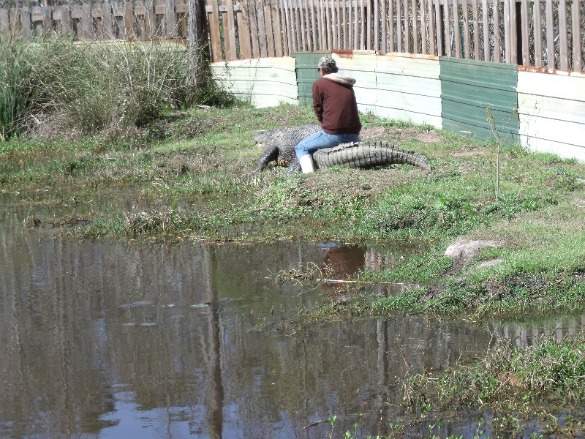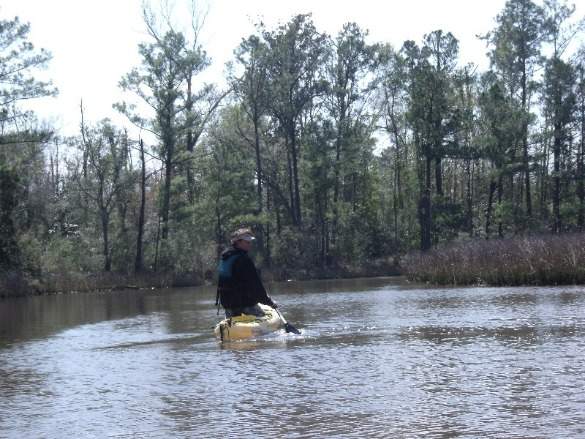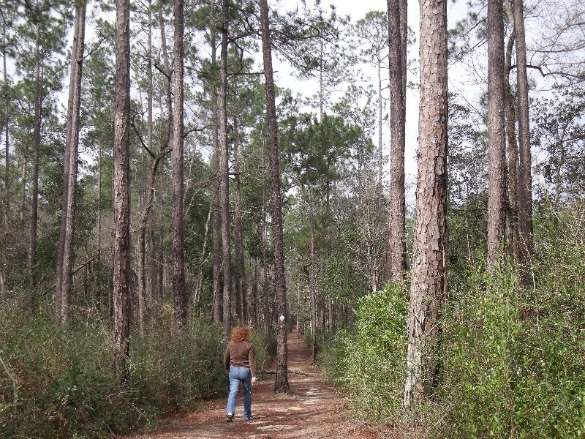The Mississippi Gulf Coast has been severely impacted via Hurricane Katrina and the BP Oil Spill, especially through perception. Nonetheless, there still remains much natural beauty and feisty wildlife to take in through light adventure activities from exploring swamp lands in an air boat to paddling through “root beer-like” waters.
Getting safely up close and personal with gators
Gators aren’t just located in Florida or Louisiana. Just a few miles from the Alabama border at Moss Point, Gulf Coast Gator Ranch & Airboat Swamp Tours allowed me the chance to get as safely up close and personal with these legendary reptiles as I explored their 145 acre grounds on foot and in an airboat. The ranch alone contains some 200 gators who are in various stages of life from yet-to-be-hatched to adult. Many can be seen via a walkway that goes through their living quarters.
The air boats exude out a really loud sound because of the Chevy 454 engines that power them (ear protection is provided). They can go 35-40 mph and are quite agile on the water, for as our driver and guide Tim sped up in the murky swamp, it felt as if I was gliding on air. Early on, and across from a train trestle, one large adult gator was spotted with its head and body partially above the water. Around that time, Tim told us the story of how he used to use chicken bait to attract the creatures, but one 10-footer named “Suzanne” smelled the blood of the chicken and was able to get on the boat briefly to try to get at the guide before he dashed away in the nick of time. “Suzanne” immediately got off boat. Blood-free marshmallows are now used as bait to try to attract the gators.
As we took sharp turns in the murky swamp waters I could feel the winter chill in the air. We kept our eyes focused on trying to spot some more large gators, but would only see a little baby who didn’t show much interest in eating the marshmallows tossed at it. The sunny but windy day didn’t bring out a lot of what we were hoping for since these reptiles are more likely to emerge as the temperatures get warmer.
Riding the gator
Tim may not have been able to find us a lot of gators in the swamp, but he more than made up for it by what he did afterwards. During our walking tour of the ranch, he got in front of a large gator lazily sunning itself, touching its nose, and then proceeded several feet to where a humungous 13-footer was lounging around. As he approached, he gave us a tip about approaching the reptiles from behind (while not recommending we actually try it): always announce yourself because if you sneak up on one, it will often react by trying to bite! After announcing himself, he got on the gator’s back and it proceeded to give him a piggyback ride for a few feet until it started hissing, causing Tim to dismount quickly but carefully.
Our tour ended with the chance to do one of those “bucket list” type of activities: hold a gator in one’s hands. I took an 18 month old from Tim by putting a couple fingers each on the baby’s tail and then neck to make the transfer safe. These little fellas have a semi-soft feel to them. The one I held was about a foot long and acted pretty gentle, barely squirming to get out of my hold, which leads to another tip: if you’re holding a baby alligator in your hands, don’t panic if it squirms: releasing its neck suddenly can mean getting bit with its sharp teeth.
Kayaking through marsh inlets
Kayaking has become one of my favorite light adventure activities. There’s such a peaceful feeling I get as I take in some of Mother Nature’s best offerings from the water. The Gulf Islands National Seashore section in Ocean Springs would be the setting for my latest kayaking foray. It was long inhabited by Native Americans before Europeans began setting foot on it in the 16th century. The venue is open in spite of last year’s oil spill. The protected area I was to do some paddling at is known as the Davis Bayou, where the marsh inlets are a mix of fresh water and salt water (brackish).
My “Da Beach House” guide Todd has the nickname of “Turtle,” given to him by his grandmother. He’s very akin to the waters, having lived in these parts as well as Hawaii for much of his life. He told me to be on the lookout for such creatures like alligators, who left evidence of their existence on the small marsh islands through the downed grass. Todd deemed gators as skiddish around kayaks and paddles.
My kayak was a 12 foot Hobie Revolution with kick pedals. The 58 pound vessel can even be fitted with a sail, but I was content with traditional paddling in waters described by “Turtle” as being that of “root beer” because of its color (NOT from the oil spill). As I paddled, glided, and swirled a bit in the mildly breezy and sunny conditions, my eyes caught the sight of cypress, live oak, magnolia, and sweet gum trees, many of which were broken due to the handiwork of Katrina. The depth of the waters ranged from a few inches to around six feet. As the wind blew through the grass creating a unique sound, my eyes took in several people fishing or looking for a perfect “Kodak moment” from the shores, which have about 2 miles of designated trails for land lovers. Even though my sleep account was pretty overdrawn, I got a real burst of energy being in the outdoors amidst those camera shy, but elegant Snowy Egrets.
“The Stingrays are biting”
Whenever I’ve visited a coastal city, I’ve always noticed people fishing from the piers during my jogs and/or walks. I never took the time to do so myself until I decided to make some time one morning at Biloxi’s Lighthouse Pier. Even though it was partly sunny outside, the temperature was hovering just above freezing. I wouldn’t be fishing alone, for my new friend Captain Tom Becker would be joining me. He normally charters a 40 foot boat called the Skipper, where folks can try their luck at getting some sport fish like shark, Spanish mackerel, flounder, etc. He didn’t mind catering to my apparently ill-timed appearance where the temperatures have been as cold as he’s seen in his 40-plus years of living in Biloxi.
Captain Tom expressed his dismay at the overly bad publicity that the BP Oil Spill caused on this area. He was shut down last year from June through October as the barrier islands got the brunt of the environmental disaster. Where I was fishing was fine even though the barrier islands are still being cleaned up, some in better shape than others.
A loud-mouthed drunk heckled us for being “amateurs” for not waiting to fish on the pier until the temperatures warmed up considerably. He was swigging a large can of beer and expected us to look at his photos of his 30-40 pound red drum catches. I baited my hook with some initially frozen shrimp and cast it out into the Mississippi Sound in the midst of the boisterous drunk’s jeers. It wasn’t twenty minutes until I had a real bite! So I reeled in what I thought was going to be some moss when suddenly out of the water was a little stingray weighing about a pound. The captain helped me get the stingray on the pier as it was swinging its tail around. The drunken man then warned us “amateurs” to not get stung by the creature, even as little stingrays can cause a whole lot of hurt.
I was excited for I had never caught a sting ray before. It had sucked the hook so deeply into its system that Captain Tom could only cut the line after I got my chance to pose with my catch before it was tossed back. Less than half an hour later, I caught another sting ray, a little bit bigger. My last cast of the day also saw my hook get into another stingray, even bigger than the previous two. I was careful not to make contact with the rays’ violently-swinging tails while posing with them.
Captain Tom is a very friendly man, who made conversation with the steady stream of pier walkers, many of whom came from frigid northern locales like Minnesota, Illinois, Michigan, and Manitoba. He responded to their inquiries about our fishing by saying, “The stingrays are biting.” During our 2 and a half hour excursion, I learned a lot of things about the man, including that he used to live in my hometown of Cheyenne, Wyoming when he was serving in the military during JFK’s presidency, including the Cuban Missile Crisis and also on that dark day of November 22, 1963. I could’ve stayed there all day on that pier catching stingrays. Fishing is so relaxing!
Mississippi Gulf Coast Recommendations
I enjoyed my five miles roundtrip of hiking on the Tuxachanie Trail of the De Soto National Forest. It’s off of Highway 49 about a half hour’s drive north of downtown Biloxi. The long and winding pathways are nicely “littered” with pine cones and fallen leaves. The pathway is rather wide as rail lines for logging purposes once ran through five miles of the 22.8 mile trail beginning in the early 1900s. Numerous streams run through this natural paradise. The forest is full of such trees like oak, maple, dogwood, loblolly and longleaf pine. Other vegetation that I took note of was honeysuckle and palmetto. Fire ant mounds abound off the sides of the trail, so one has to be careful. One may spot such creatures like a Cooper’s Hawk, armadillo, skunk, raccoon, or bluebirds. The trail ends at an old World War II POW camp.
I stayed at the Four Points by Sheraton in Biloxi. The beds are very comfortable, and the rooms feature free high speed internet. There’s a large business-friendly work desk in the room. The fitness center is open 24/7, and their treadmills and ellipticals have their own cable TVs attached. The hotel is across the street from the beach.
Search for cheap hotels in Biloxi, look for Louisiana travel deals, or check out our Mississippi travel guide.
All photos are courtesy of the author and may not be used without permission.
Roy A. Barnes attended a press trip sponsored by the Mississippi Gulf Coast CVB, but what he wrote are his impressions and wasn’t “vetted” by the sponsor. The author writes from southeastern Wyoming.




